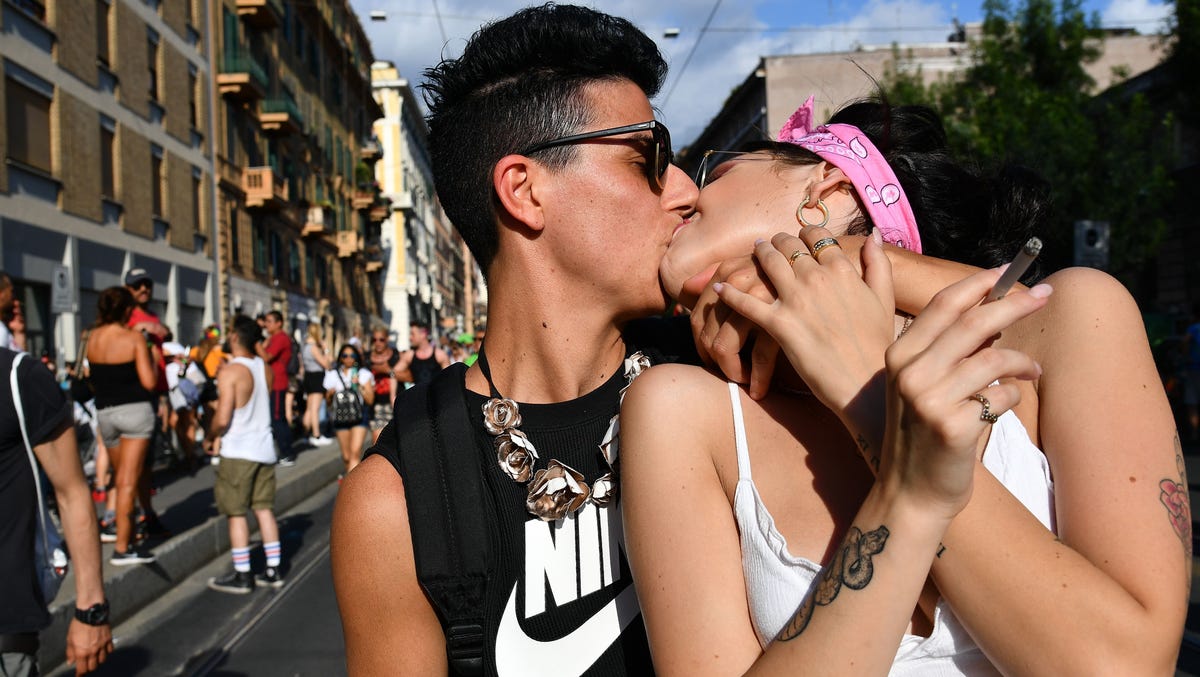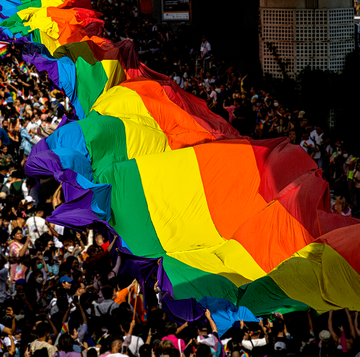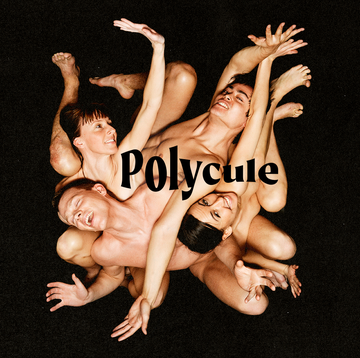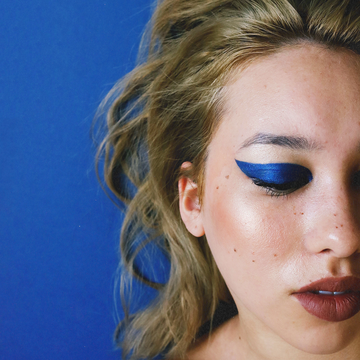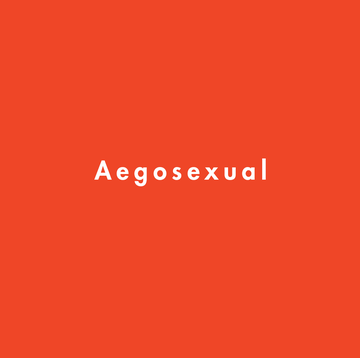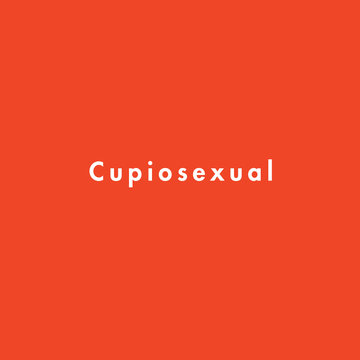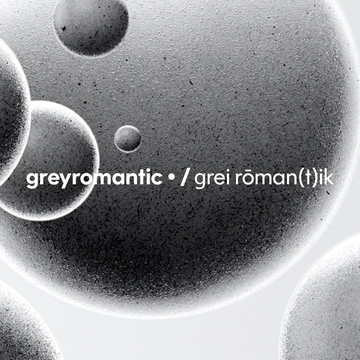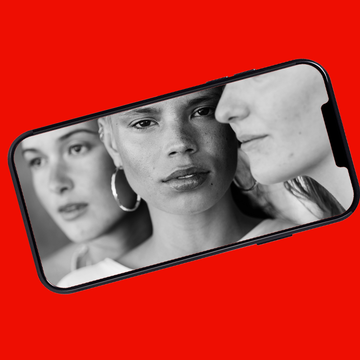We continue to have an expanding awareness of sex, gender, and sexuality, aka sexual orientation. Since language has evolved and people have continued to be open about themselves, we have a better understanding of sexual orientation—and that knowledge will only continue to grow. But no matter what, inclusive language around sexuality matters, particularly for creating safe spaces for LGBTQIA+ folks.
Whether you're exploring your sexuality, learning about others, or hoping to educate yourself and be an ally, this list is designed to help define and differentiate some commonly used terms to describe sexual orientation. However you identify, you're not alone. And GLAAD has a Media Reference Guide for a comprehensive list of terminology if you want more info.
What is sexuality?
Worth noting right away: Sexuality is different from sex or gender identity (for gender-related terms, head right this way). Sexuality is sometimes referred to as "whom you love" as opposed to "who you are" (i.e., gender identity), although that's a bit of an oversimplification. Sexual orientation is an umbrella term that covers a person's attraction—or lack thereof—and to whom. It can sometimes include romantic and emotional feelings alongside sexual ones, but romantic orientations deal specifically with romantic interest in a person. Sometimes sexual orientation (with whom you might pursue a sexual relationship) and romantic orientation (with whom you might fall in love) can be different.
Sexual orientation can also change and evolve, so one or more of these terms may feel right at the moment and then feel less of a "fit" at other points in a person's life. It's also worth noting that sexual orientation is based on someone's own understanding of themselves—not society's—and some identify with no defined sexuality at all. It's important not to speculate or ask about a person's orientation, and a smart best practice is to wait for someone to offer that information if they choose.
How many sexualities are there?
There's no fixed number of sexualities, and the below list might not include exactly how someone identifies—or whether they define their orientation differently than the commonly accepted definition. Because this number is evolving (there are already over 100 terms to describe sexuality), there may also be more to add in the future. It's important to know, though, that these are not *new* sexual orientations, simply ones that don't have names yet. Clear, specific definitions help us get closer to inclusive representation.
What are the types of sexualities?
Abrosexual
An abrosexual person is someone with fluid sexuality, whose sexuality and preferences may change throughout their lives. Different levels of sexual (and romantic) feelings through time are very common—and sometimes people identify their sexuality as "fluid"—but the distinction for an abrosexual person is that these periods of change can happen quickly and with different intensities. It can also look like changing one's actual sexual orientation.
There's no limitation or norm regarding an abrosexual person's orientation, but it often shifts between two to three sexualities in regular or random cycles, Katherin Winnick, a sex coach at LetsTalkSex.net, has told Cosmo.
Allosexual
Allosexual simply means a person who experiences any kind of sexual attraction—so it covers sexualities on this list that don't fall under asexuality. The asexual community has called attention to the privilege inherent in this identity since it's considered the "norm" sexuality.
Androsexual
There are a few definitions of androsexuality, but the most common is "a person who is attracted to individuals on the masculine side of the gender spectrum," Dr. Jay Irwin, associate professor of sociology at the University of Nebraska at Omaha, has told Cosmo. "Sometimes this is interpreted as individuals who are attracted to cisgender men (that is, people who were assigned male at birth and also identify as a man), but that binary-based definition is typically too narrow for how individuals who identify as androsexual see their sexuality."
So it may mean, for example, that an androsexual person is attracted to aspects of masculinity regardless of one's sex assigned at birth, including physical appearance, behavior, smell, and so on. A lesser-used definition of androsexual is someone who is attracted to nonbinary people.
Asexual
Asexual can be a catch-all that very broadly means a person who doesn't experience sexual attraction to other people. Although there's a false stereotype to the contrary, asexual people may want friendships, emotional intimacy, and potentially love connections. Note: Asexual is also not the same as celibate, which is the choice not to have sex.
“[If you are asexual], you may desire close relationships with people, even romantic ones, but the idea of touching each other’s genitals is not particularly thrilling,”sexologist Timaree Leigh, PhD, has told Cosmo.
Autosexual
An autosexual person has a specific sexual attraction towards themselves (sometimes it's wrongly confused with narcissism, which is characterized by lack of empathy and the need for adulation—and is not a sexuality). “People who are autosexual are able to have relationships with others, but have a preference for sex with themselves,” Megwyn White, director of education for Satisfyer, has told Cosmo.
"If you get turned on by watching yourself have sex in the mirror or get aroused by posing in erotic lingerie, that’s not necessarily a sign of autoeroticism," Katherine Hertlein, MD, expert advisor at sex therapy app Blueheart, has told Cosmo. "However, if the thought of having sex with yourself turns you on or you have to think about yourself to climax, then you’re probably an autosexual."
Bisexual
A bisexual person has an attraction to more than one gender. It can be used somewhat interchangeably with pansexual (see below), but bisexuality can mean attraction to your own gender as well as other genders. It doesn't need to be an equal attraction to particular genders, either ("bi" people don't necessarily just date in the binary, i.e., only men and women).
Daniel Saynt, founder of the New Society for Wellness (NSFW) members-only sex club in New York, NY, has told Cosmo the term “bisexual” is actually “the blanket designation for anyone who is pansexual, demisexual, sapiosexual, trysexual, homoflexible, heteroflexible, curious, questioning, undecided, or fluid.” In part, because of its broad definition, it makes up the largest percentage of the LGBTQIA+ community.
Ceterosexual
Someone who is attracted to folks who are transgender, non-binary, and (sometimes) not cisgender. It used to be called "skoliosexual," but because that means "crooked" in Latin, it's no longer considered an appropriate term and shouldn't be used. The term isn't without controversy—it can be viewed as fetishizing. Someone who is ceterosexual may also be trans or non-binary, Marla Renee Stewart, sexpert for Lovers, has told Cosmo.
Closeted
This isn't a specific sexuality per se, and more of an indication that a person is not "out" (i.e., publicly acknowledging) some or all aspects of their orientation. This might be for a whole host of reasons, including safety and personal preference.
Cupiosexual
This falls under asexuality as a person who wants a sexual relationship with a person or people but experiences little to no attraction. The term is rising in popularity; They may enjoy the experience of sex without being attracted to anyone. "An asexual person simply does not feel sexual attraction, but may have sex for a host of reasons, including the physical pleasure of sex or the pleasure of their partner(s)," Tanya M. Bass, PhD, sexologist, has told Cosmo.
Demisexual
Technically, demisexuality falls under the umbrella of asexuality, but it actually speaks to “people who...only form a sexual attraction to a person once they have formed a close emotional bond with them,” Kayla Kaszyca, demisexual activist and cohost of the Sounds Fake but Okay podcast, has told Cosmo. So, they're capable of sexual attraction in specific circumstances. You might remember that Michaela Kennedy-Cuomo came out as demisexual in 2021. This New York Times Modern Love essay explores attraction from the perspective of a demisexual person.
Gay/Lesbian
Someone who experiences exclusive physical, romantic, and/or emotional attraction to people of their same gender. A lesbian is specifically someone who identifies as a woman and is attracted to women; some people prefer to use this self-identification. FYI, the term "homosexual" or "homosexuals" is considered outdated, derogatory, and offensive, per GLAAD.
Greysexual/Graysexual/Grey-Ace/Gray-Ace
Also under the asexuality spectrum, a graysexual person may occasionally experience sexual attraction and feelings—but it's the exception, not the norm. They might experience attraction a few times in their life or more, but it's at a lower rate than average. It can be helpful to think of a graysexual person as asexual “for the vast majority of their lives but having infrequent periods where they feel sexual attraction,” Ashley Harris, a dating and relationship coach with BeyondAges.com, has told Cosmo. “Outside of these rare occurrences...they are virtually identical to asexual individuals.”
Gynesexual
Someone who's gynesexual is attracted to women, females, and/or femininity, regardless of sex assigned at birth. (It's the opposite of being androsexual, which is attraction to masculinity or "maleness" regardless of sex assigned at birth. It's also different from identifying as gay or lesbian.)
Heteroflexible or Homoflexible
A heteroflexible person is someone who primarily feels attracted to people of their opposite gender but may be open (flexible) to sexual experiences outside that category. Dr. Christopher Ryan Jones, sex therapist, has told Cosmo, “In general, it means that the person considers themselves heterosexual despite the fact that they are willing to participate in sexual activities with someone of the same sex or gender. It means different things to different people, because the situations surrounding the ‘flexibility’ vary greatly from one person to another.”
Conversely, someone who is homoflexible considers themselves primarily attracted to people of their same gender but may occasionally be attracted to sexual activity with people not of the same gender.
Heterosexual/Straight
Someone who's heterosexual experiences exclusive physical, romantic, and/or emotional attraction to people of their opposite gender.
Multisexual
Bisexuality, omnisexuality (below), pansexuality, and some definitions of queer (below) all exist under the identity "multisexuality."
Omnisexual
An omnisexual person can be romantically and/or sexually attracted to all people, no matter the gender (someone who experiences only romantic feelings may be referred to as omniromantic). They can experience attraction to different genders in different ways, and they're not "blind" to gender differences. As Courtney D’Allaird, assistant director of Gender and Sexuality Resource Center at the University of Albany, has told Cosmo, it might sound like, “‘I’m attracted sexually to people, and when I am with someone, their gender matters. I see it, but [gender] is not why I am attracted—and it’s not a factor when I am attracted to them.’”
Pansexual
Attracted to people of any gender. As sex therapist Kelly Wise has told Cosmo, a pansexual person is “someone who is attracted to people regardless of gender or biological sex. That is irrelevant. Pansexuality holds space for the idea that gender is very fluid.” For a pansexual person, their attraction lies in personality, vibes, energy, morals, and/or other attributes. Celebrities like Sam Smith, Janelle Monáe, and Miley Cyrus have identified themselves as pansexual.
Polysexual
Someone who is attracted to many (but not necessarily all) genders and identities—also, it can be confused with but is not the same as polyamory, which is a relationship style that engages in multiple consenting romantic and/or sexual relationships.
A polysexual person may ignore the gender binary as it pertains to their attraction to others. As Cameron Glover, a certified sex educator and business coach, has told Cosmo: “Usually, when we talk about sexuality, it’s very much rooted in binaries—so, man/woman or nonbinary folks...But I think there is a conversation that can be had looking at sexuality beyond that.”
Polysexuality can look different for each person, explains Glover—but can include, for example, being attracted to all genders except cisgender men or attracted to masculine-presenting folks regardless of gender.
Pomosexual
For a person who's pomosexual, their sexuality doesn't fit into a particular category—and/or they reject labels around their orientation entirely. It can be both an umbrella term and a sexuality; A pomosexual person may feel attraction, but they don't want to elaborate on how, how often, and to whom.
Queer
Queer can be a blanket term to describe someone in the LGBTQIA+ community, but it can also describe a person who identifies as gay. It used to be a derogatory term, but it's now being reclaimed as a positive expression of one's orientation, gender identity, or inclusion in the LGBTQIA+ community.
Questioning
As the name implies, a person who's questioning their sexuality may not yet be identifying with a particular orientation. Sometimes, someone might identify themselves as "curious" or "bi-curious" (someone exploring whether they're bisexual), but these terms can also be associated with the mistaken belief that queer sexual orientation is just a phase, and thus some people don't use it. The "Q" in LGBTQIA+ holds space for people exploring and discovering their orientation—and a person can be questioning for as long as they need.
Katherine J Igoe (she/her) was a contributing editor for Cosmopolitan and is a freelancer covering style, lifestyle, culture, and beauty (she's obsessed with gift guides, best-of movie lists, and beauty products). She's been a freelance writer and editor for over a decade, previously working for Marie Claire (2018 to 2021) and Bustle (2021), with bylines in the The New York Times, Parents magazine, and elsewhere. She lives in Boston with her family, and you can follow her on Instagram or Twitte. It's "I go to dinner," not "Her huge ego," but she responds to both.

